Having a professional writing portfolio is crucial for any writer looking to stand out. Writing portfolio websites not only showcase your work but also establish your credibility in a competitive market.
With over 70% of writers stating that a well-designed portfolio significantly increases their chances of being hired, it’s clear that the right platform can open doors to new opportunities.
In this comprehensive guide, we’ll explore the top 11 writing portfolio websites available in 2025.
Whether you’re a freelance writer seeking to attract clients or a professional looking to showcase your skills, this research-backed list has you covered.
Key Takeaways
- A professional writing portfolio is essential for establishing credibility and attracting opportunities.
- Many platforms offer unique features tailored to different types of writers and their specific needs.
- Understanding pricing and functionalities can help you choose the right portfolio website for your career goals.
Top 11 Picks for Writing Portfolio Websites
- Portfolio Website Maker by Hostinger – Best for writers who want an all‑in‑one solution.
- Authory – Best for writers publishing heavily online.
- Journo Portfolio – Ideal for tech-savvy writers looking for stylish templates.
- Writer’s Residence – User-friendly system for sharing work and building a brand.
- Clippings.me – A free option for writers needing basic functionality.
- Muck Rack – Aimed at journalists, connecting them with PR professionals.
- Medium – Great for publishing and engaging with a writing community.
- Squarespace – Versatile website builder for various portfolio types.
- Wix – User-friendly drag-and-drop editor with ample templates.
- Adobe Portfolio – Ideal for creative professionals using Adobe tools.
- Copyfolio – Simple design focused on written content, including blogging features.
How We Evaluated Writing Portfolio Websites
The evaluation process for writing portfolio websites focused on these key criteria:
- Ease of Use: User-friendly interfaces that allow writers to navigate and set up their portfolios effortlessly.
- Customization Options: The ability to personalize portfolios with custom domains and themes.
- SEO Features: Tools that help increase visibility on search engines, crucial for attracting potential clients.
- Integration Capabilities: Compatibility with other tools such as social media, analytics, and content management systems.
- Pricing Structures: Affordability and value for money, including free trials and tiered pricing options.
Our methodology included extensive online research, user feedback, and expert consultations to ensure a well-rounded evaluation of each platform.
Writing Portfolio Websites Comparison Table
| Software | Best For | Key Features | Pricing | Free Plan | Platforms Available |
|---|---|---|---|---|---|
| Portfolio Website Maker by Hostinger | Writers wanting an AI‑driven, all‑in‑one solution | AI website generator, 170 templates, AI marketing/SEO tools | From $2.49/mo (48‑mo term) | No | Web |
| Authory | Writers publishing online | Auto-aggregation, SEO tools, attractive themes | $15/month (or $12/month annually) | No | Web |
| Journo Portfolio | Tech-savvy writers | Custom domains, PDF backups | $12/month (or $8/month annually) | Yes | Web |
| Writer’s Residence | User-friendly setup | SEO integration, Google Analytics | $9/month | Yes | Web |
| Clippings.me | Basic functionality | Free version, straightforward setup | $9.99/month (or $8.25/month annually) | Yes | Web |
| Muck Rack | Journalists | Networking tools, comprehensive portfolio | Custom pricing | No | Web |
| Medium | Writers seeking community engagement | Self-publishing, clean writing interface | Free (premium available) | Yes | Web, iOS, Android |
| Squarespace | Versatile portfolio options | Customizable templates, e-commerce features | Starting at $16/month | No | Web |
| Wix | Beginners and non-tech-savvy users | Drag-and-drop editor, wide variety of templates | Starting at $17/month | Yes | Web |
| Adobe Portfolio | Creative professionals using Adobe | Integration with Adobe products, customizable | Included with Adobe Creative Cloud | No | Web |
| Copyfolio | Simple design with blogging features | Easy sign-up, free version | $15/month (or $9/month annually) | Yes | Web |
1. Portfolio Website Maker by Hostinger
Best for writers wanting an AI‑powered, all‑in‑one solution.
Portfolio Website Maker by Hostinger isn’t just a platform to display your work, it’s a complete website builder that bundles web hosting, a custom domain and marketing tools into one subscription.

You can choose between an AI‑generated site or 170 fully customizable templates and edit them with a drag‑and‑drop interface. The Premium plan limits you to one website with five pages and 2 GB storage, whereas the Business plan lets you build up to 50 websites with unlimited pages and adds e‑commerce functionality.
Pros
- Extremely affordable.
- AI tools (website generation, writing and image tools, SEO assistant).
- All‑in‑one package.
- Drag‑and‑drop editing.
Cons
- Limited expansion on lower plan.
- No free plan.
- Price hikes at renewal.
- No app marketplace.
Key Features
- AI website generator with 170 templates.
- Integrated marketing and SEO tools.
- E‑commerce support with 0 % transaction fees.
- Free domain and email for the first year.
Pricing
Premium plan starts from $2.49/month (48‑month term) with a free domain, 2 GB storage and 170 templates. Business plan starts from $3.29/month (48‑month term) with unlimited pages, 50 GB storage, e‑commerce features and AI tools like AI writer and AI image generator. Prices increase upon renewal.
2. Authory
Best for writers publishing heavily online.
Authory simplifies the portfolio creation process by automatically aggregating your published work from various online sources.
This platform is perfect for writers who frequently publish articles, as it keeps your portfolio updated without needing manual inputs.
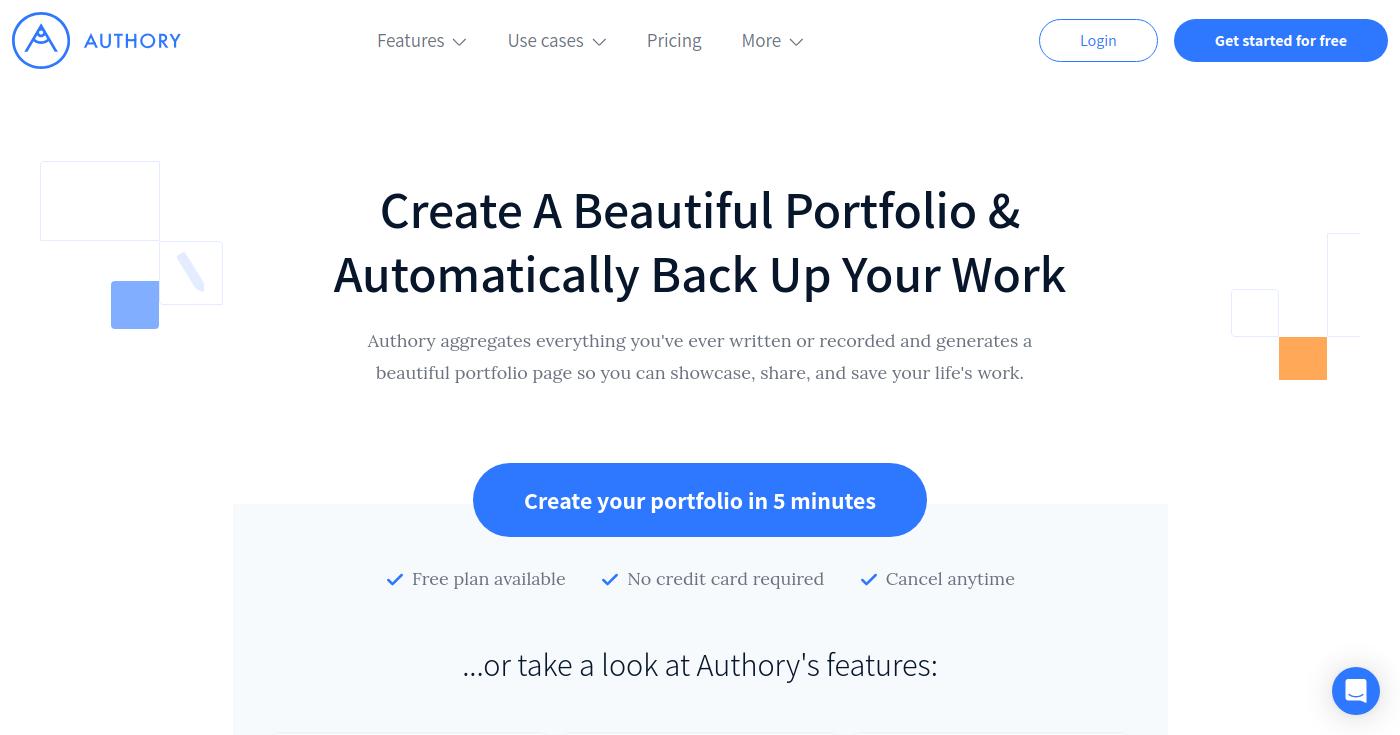
Pros
- Great for writers who publish frequently.
- Easy to manage and update content.
Cons
- More suitable for content writers; less ideal for those whose work isn’t published online.
- May be overwhelming for non-tech-savvy users.
Key Features
- Auto-aggregation of content from various sources.
- Attractive themes designed for writers.
- SEO tools to enhance visibility.
Pricing
Authory is priced at $15/month or $12/month when billed annually. For more details, visit their pricing page.
3. Journo Portfolio
Ideal for tech-savvy writers looking for stylish templates.
Journo Portfolio offers a sleek interface with customizable themes, allowing writers to create a professional-looking portfolio easily.

Pros
- Attractive, customizable themes.
- 50% discount for students.
Cons
- Changing themes can delete pages and content.
- Extensive options may overwhelm some users.
Key Features
- Supports various digital creators, not just writers.
- Allows for PDF and JPEG backups of writing samples.
- Custom domains available.
Pricing
Journo Portfolio starts at $12/month or $8/month when billed yearly. Check their pricing page for more details.
4. Writer’s Residence
User-friendly system for sharing work and building a brand.
Writer’s Residence is designed to make portfolio creation easy for writers. With a focus on usability, it helps writers present their work effectively.

Pros
- Easy to use and set up.
- Generous 30-day free trial.
Cons
- No free option available.
- Limited to writing portfolios, not ideal for designers.
Key Features
- User-friendly setup with a focus on readability.
- Custom domain support.
- SEO integration and Google Analytics tracking.
Pricing
Writer’s Residence is available for $9/month. Visit their pricing page for more information.
5. Clippings.me
A free option for writers needing basic functionality.
Clippings.me is a simple portfolio platform that allows writers to create a portfolio for free, with premium features available for more serious users.

Pros
- Offers a free version to test the platform.
- Simple and easy to navigate.
Cons
- Basic themes with limited customization.
- Free version includes Clippings.me branding.
Key Features
- Allows a free version limited to 10 pieces of content.
- Straightforward setup process.
Pricing
Clippings.me starts at $9.99/month or $99/year when billed annually. For more details, check their pricing page.
6. Muck Rack
Aimed at journalists, connecting them with PR professionals.
Muck Rack is tailored for journalists, offering tools to create a comprehensive portfolio while connecting with public relations professionals.
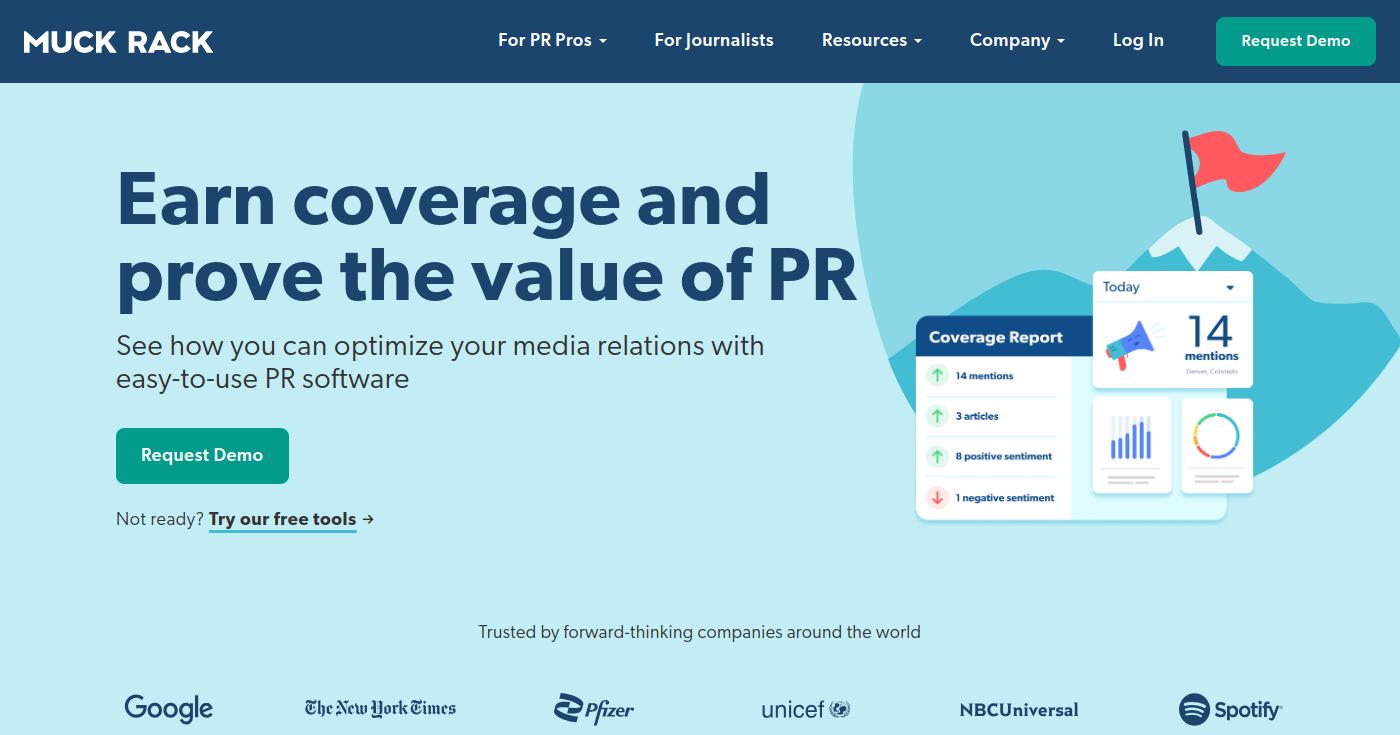
Pros
- Strong networking opportunities for journalists.
- Comprehensive portfolio tools.
Cons
- Primarily designed for journalists; may not suit all writers.
Key Features
- Tailored for journalists with a focus on PR connections.
- Offers a suite of tools for portfolio creation.
Pricing
Muck Rack operates on custom pricing based on user needs. Visit their pricing page for more information.
7. Medium
Great for publishing and engaging with a writing community.
Medium is a powerful platform that allows writers to publish their work and engage with a community of readers and fellow writers.
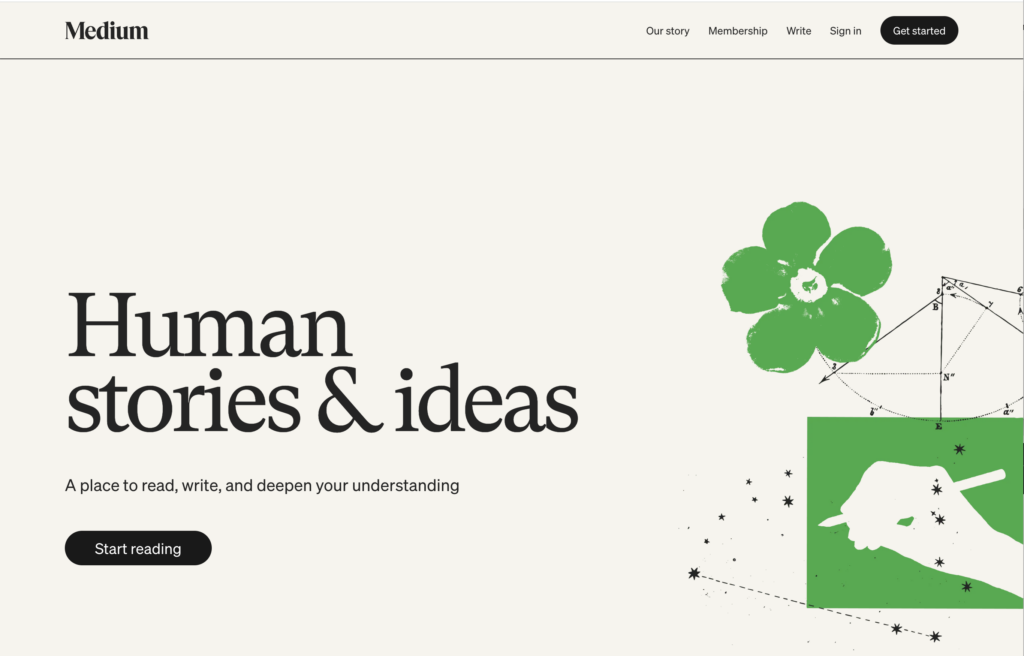
Pros
- Great for visibility and networking.
- Simple and clean writing interface.
Cons
- Not a traditional portfolio site; more of a publishing platform.
- Limited customization options for personal branding.
Key Features
- Self-publishing platform for writers.
- Community engagement through stories and publications.
Pricing
Medium is free to use, with premium features available. Explore their offerings on their website.
8. Squarespace
Versatile website builder for various portfolio types.
Squarespace is a popular website builder that allows writers to create visually appealing portfolios with extensive customization options.

Pros
- Versatile for various types of portfolios, including writing.
- Strong e-commerce capabilities.
Cons
- Can be complex for beginners.
- More expensive compared to dedicated writing portfolio sites.
Key Features
- Drag-and-drop website builder.
- Highly customizable templates.
Pricing
Squarespace starts at $16/month. For more pricing options, visit their pricing page.
9. Wix
User-friendly drag-and-drop editor with ample templates.
Wix provides a range of templates and a simple drag-and-drop editor, making it accessible for writers of all tech levels.

Pros
- Excellent for beginners and non-tech-savvy users.
- Offers free plan options.
Cons
- Limited SEO capabilities on free plans.
- Branding on free versions can appear unprofessional.
Key Features
- User-friendly drag-and-drop editor.
- Wide variety of templates.
Pricing
Wix starts at $17/month. To learn more about their offerings, check their pricing page.
10. Adobe Portfolio
Ideal for creative professionals using Adobe tools.
Adobe Portfolio is perfect for writers who also utilize Adobe Creative Cloud, allowing for seamless integration and strong visual presentation.
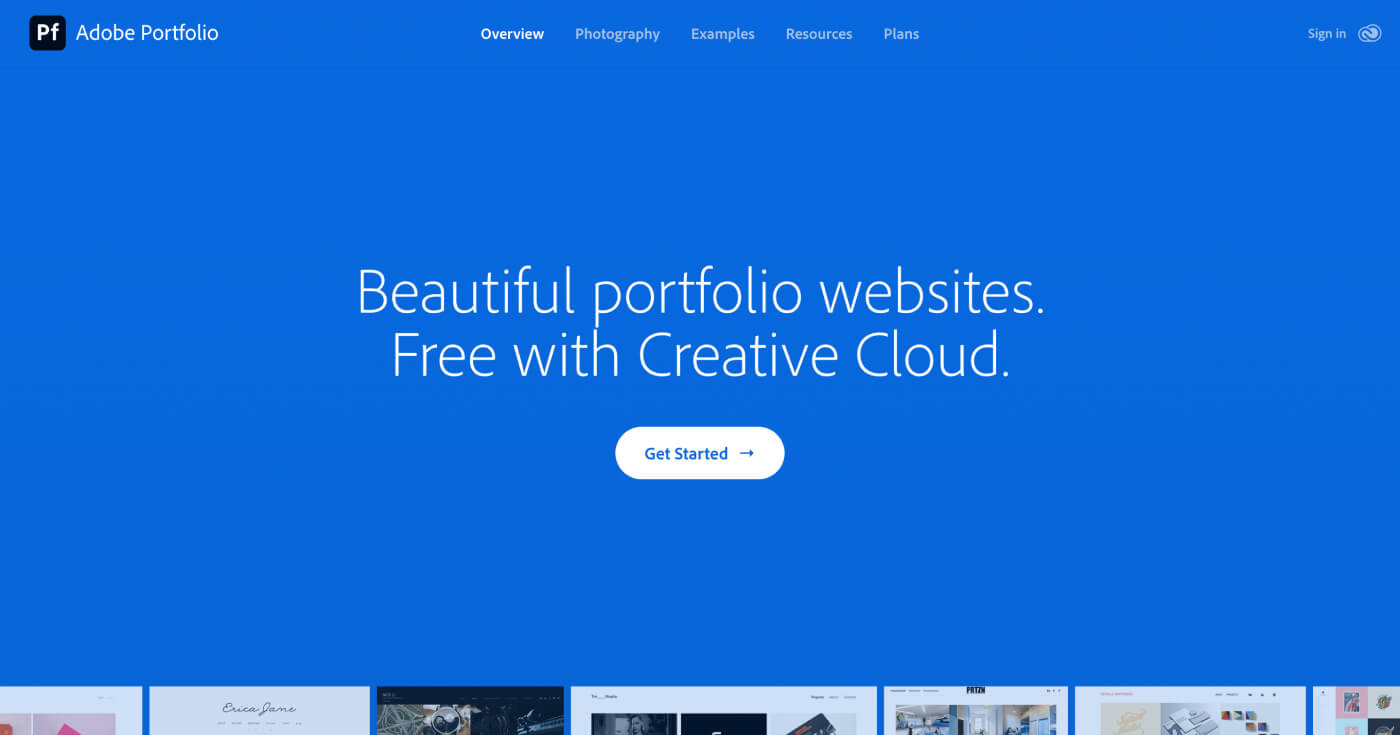
Pros
- Ideal for those already using Adobe software.
- Strong visual design capabilities.
Cons
- Requires a subscription to Adobe Creative Cloud.
- Not exclusively focused on writing.
Key Features
- Seamless integration with Adobe products.
- Customizable portfolio templates.
Pricing
Adobe Portfolio is included with an Adobe Creative Cloud subscription. For more details, visit their website.
11. Copyfolio
Simple design focused on written content, including blogging features.
Copyfolio provides a straightforward way to showcase your writing, featuring blogging options and user-friendly design.
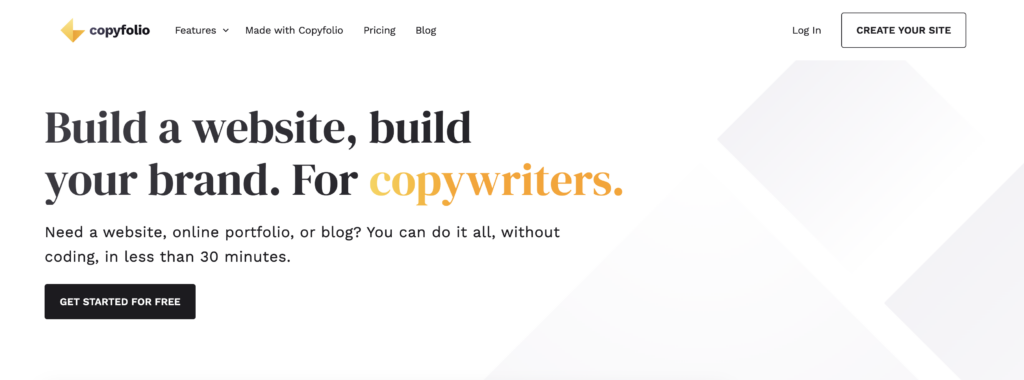
Pros
- Free version available (limited to 3 pages).
- User-friendly sign-up process.
Cons
- Free version is minimal and not suited for professional sharing.
- Themes may be overly stylized, detracting from content readability.
Key Features
- Blogging features included.
- Extensive theme options.
Pricing
Copyfolio is available for $15/month or $9/month when billed annually. For more information, visit their pricing page.
How to Choose the Right Writing Portfolio Websites for Your Needs
Selecting the ideal writing portfolio website depends on your specific requirements and use case. Consider these crucial factors:
- Ease of Use: Look for platforms that allow for simple navigation and set-up.
- Customization Options: Ensure the platform supports custom domains and personal branding.
- SEO Features: Choose a site that enhances your online visibility through effective SEO tools.
- Budget: Consider your investment and evaluate the return on investment for your writing career.
Emerging Trends in Writing Portfolio Websites
In 2025, we’re seeing a shift towards more integrated platforms that combine portfolio creation with social networking features. The rise of community-centric platforms like Medium is blurring the lines between traditional portfolios and self-publishing, prompting writers to think more about how they interact with their audiences online.
As the market evolves, tools that allow for greater interactivity and engagement are becoming increasingly valuable.
Making the Right Choice
Choosing the right writing portfolio website is essential for showcasing your work and attracting potential clients. Each platform has its unique features and pricing structures, so evaluate your specific needs to find the best fit.
Whether you’re just starting or looking to enhance your existing portfolio, exploring these top picks can guide you toward creating an impressive online presence that effectively highlights your skills.
Frequently Asked Questions
Most common questions when choosing a writing portfolio platform.
What is the best platform for a writing portfolio?
The best platform depends on your specific needs; platforms like Authory and Journo Portfolio are excellent for frequent publishers, while Clippings.me offers a free option for beginners.
How to create a professional writing portfolio?
Select a user-friendly platform, choose a clean design template, and include writing samples that showcase your best work. Don’t forget to add an “About Me” section and contact information.
What features should a writing portfolio website have?
Look for customization options, SEO tools, user-friendly navigation, and analytics to track engagement.
How do pricing structures vary among portfolio websites?
Pricing can range from free to around $15/month, with some platforms offering discounts for annual billing or for students.
What are the future trends in writing portfolio websites?
Expect to see more community-focused features that blend portfolio creation with social networking, enhancing visibility and engagement for writers.
